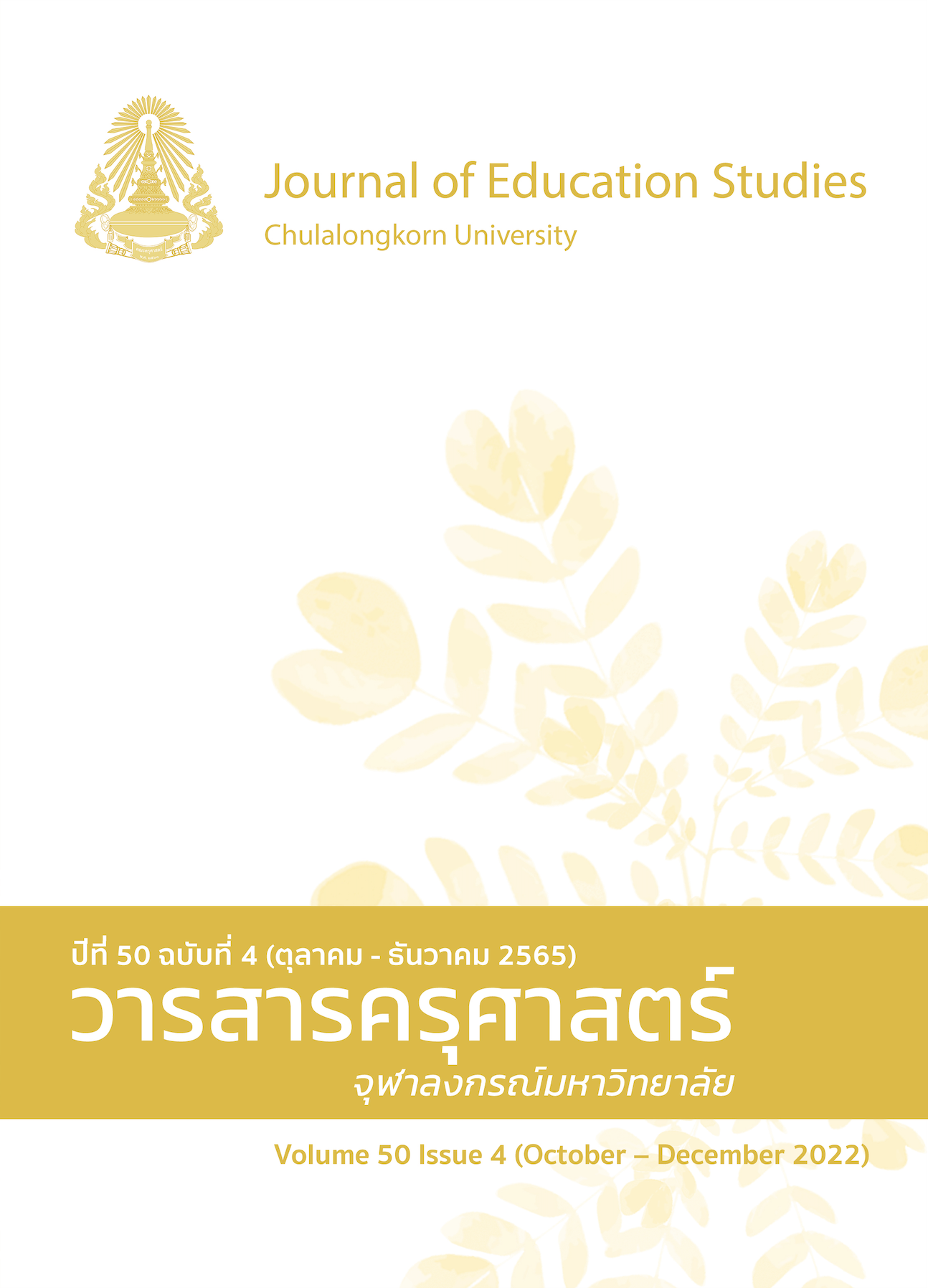Innovation Teaching Series to Promote Speaking Thai for Ethnic Students
DOI:
https://doi.org/10.14456/educu.2022.33Keywords:
ethnic group students, teaching series, ability to speak ThaiAbstract
The objectives of this research were 1) to create an innovative teaching package called “Audio book Thai accent” to promote Thai speaking to students of different ethnic groups, 2) to study the results from using the teaching package to teach students of different ethnic groups, and 3) to assess the satisfaction of these students using the teaching package. The target group consisted of 20 students from a variety of ethnic groups who experience several problems with speaking Thai. The group consisted of 5 students from the Lahu, Akha, Pga K'nyau, and Hmong ethnic groups, who share problems with speaking Thai initial consonants, vowels, final consonants, tones, and diphthongs. The research instruments were 1) a Thai Speaking Ability Test, 2) the “Audio book Thai accent” Teaching Innovation Series, and 3) a form for assessing the students’ satisfaction with the teaching package. The results of the study resulted in the design of the “Audio book Thai accent”, consisting of 5 practice sets, namely (1) a set of training organs on Thai pronunciation, (2) a set to practice speaking Thai from words, (3) a set to practice speaking Thai from sentences, (4) a set to practice speaking Thai from words from local stories, and (5) Thai speaking assessment kits. The study found that 1) the efficiency of the package was 82.80/86.00, 2) the students’ ability to speak Thai after using the package improved with an average increase in score of 25.75 percent, and 3) the students were satisfied with the use of the package at the most levels.
References
ภาษาไทย
ขจัดภัย บุรุษพัฒน์. (2538). ชาวเขา. แพร่พิทยา.
เตือนใจ ตรีเนตร. (2544). ผลของการใช้แบบฝึกการแก้โจทย์ปัญหาคณิตศาสตร์ เรื่อง พื้นที่ สำหรับนักเรียนชั้นมัธยมศึกษา
ปีที่ 2 [สารนิพนธ์ปริญญามหาบัณฑิต ไม่ได้ตีพิมพ์]. มหาวิทยาลัยศรีนครินทรวิโรฒ.
พัชรี พลาวงศ์. (2536). การเรียนด้วยตนเอง. วารสารรามคำแหง, 82-91.
พวงรัตน์ ทวีรัตน์. 2543. วิธีการวิจัยทางพฤติกรรมศาสตร์และสังคมศาสตร์ (พิมพ์ครั้งที่ 7). สำนักทดสอบทางการศึกษาและ
จิตวิทยา มหาวิทยาลัยศรีนครินทรวิโรฒ.
มยุเรศ รัตนานิคม. (2542). สัทอักษรกับการออกเสียงภาษาอังกฤษ. มหาวิทยาลัยราชภัฎสกลนคร.
มานิต มานิตเจริญ. (2550). พจนานุกรมไทย (พิมพ์ครั้งที่ 23). วี. เจ. พริ้นติ้ง.
รุสลาน สาแม และ เปรมินทร์ คาระวี (2558). กฤตกรรมการออกเสียงพยางค์หนัก-เบา ในคำภาษาอังกฤษจากผลของ
การสอนแบบฟัง-พูด ร่วมกับการสอนความรู้ทางสัทศาสตร์. วารสารศึกษาศาสตร์ มหาวิทยาลัยสงขลานครินทร์,
(3), 93-108.
ล้วน สายยศ และ อังคณา สายยศ. (2538). เทคนิคการวิจัยทางการศึกษา (พิมพ์ครั้งที่ 4). วิริยาสาส์น.
ศศิธร ธัญลักษณานันท์. (2542). พฤติกรรมการสอนภาษาไทยในชั้นมัธยมศึกษา. สถาบันราชภัฎนครราชสีมา.
สุวัฒนา เลี่ยมประวัติ. (2545). เสียงและระบบเสียงภาษาไทย. ภาควิชาภาษาไทย คณะอักษรศาสตร์ มหาวิทยาลัยศิลปากร.
สุวิไล เปรมศรีรัตน์. (2545). รายงานการวิจัยแผนที่ภาษาของกลุ่มชาติพันธุ์ต่าง ๆ ในประเทศไทย. สำนักคณะกรรมการ
วัฒนธรรมแห่งชาติและสถาบันวิจัยภาษาและวัฒนธรรมเพื่อพัฒนาชนบท มหาวิทยาลัยมหิดล.
อนันตา สุขวัฒน์. (2564).พลวัตวัฒนธรรมกลุ่มชาติพันธุ์อาข่า ผาหมี จังหวัดเชียงราย. วารสารสังคมศาสตร์วิชาการ, 14(1),
-48.
อังศุมาลิน เพิ่มผล. (2542). การสร้างแบบฝึกทักษะการคำนวณวิชาคณิตศาสตร์เรื่องวงกลม สำหรับนักเรียนชั้นมัธยมศึกษา
ปีที่ 3 [สารนิพนธ์ปริญญามหาบัณฑิต ไม่ได้ตีพิมพ์]. มหาวิทยาลัยศรีนครินทรวิโรฒ.
ภาษาอังกฤษ
Avery, P., & Ehrlich, S. (1992). Common pronunciation problems. Journal of Education Studies: Oxford
University, 23, 121-125.
Bamrungrak, C., & Ronnakiat, N. (2015). “What is the language?” in language and linguistics. International
Education Studies, Thammasat University.
Enriquez, J. (2001). As the future catches you. Research and Practice in Technology Enhanced Learning:
Tuttle-Mori, 12, 53.
Kelly, G. (2003). How to teach pronunciation. Asia-Pacific Journal of Teacher Education, 38(2), 147-159.
Ladefoged, P. (2006). A course in phonetics (5th ed.). Cengage Learning.
Kimble, G. A. (1964). Hilgard and marquis conditioning and learning. Teaching and Teacher Education, 20,
-257.
Kemmis, S., & McTaggart, R. (1990). The action research planner (3 rd ed.). Deakin University.
Lawis, P. (1972). Phonettic problems involed in teaching Thai to speakers of Lahu and Akha. In G. H.
Jimmy & B. N. Richard (Eds.) Tai phonetics and phonology. (p.291). Mahidol University.
Nitta, K. K. (2004). Developing communicative competence in Japanese forth-grade English language
learning. Delta Kappa Gamma Bulletin, 70(1), 55-56.
Rogers, C. R. (1951). Client – centered therapy. Houghton Mifflin.
Selinker, L. (1977). Interlanguage. In J. C. Richard & T. Rodgers (Eds.), New directions in second language
learning teaching and bilingual education. (pp. 31-54). TESOL.
Thorndike, E. L. (1966). Human learning. M.I.T.
Thompson, L. W. (1996). Cognitive–behavioral therapy and treatment for late-life depression. Journal of
Clinical Psychiatry, 57(5), 29–37.
Wei, Y. F., & Zhou, Y. L. (1999). Correct pronunciation. Naresuan University Journal, 7(1), 36-38.
Downloads
Published
How to Cite
Issue
Section
License

This work is licensed under a Creative Commons Attribution-NonCommercial-NoDerivatives 4.0 International License.




